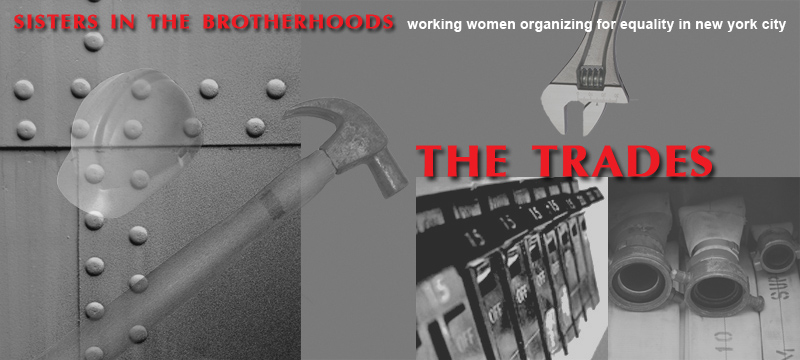 |
||||||
Carpenters: Against the Grain Ever since women entered the New York City District Council of Carpenters (NYDDC) in 1978, they've been part of an ongoing effort to make the carpenters' union more responsive to their presence. Women have traveled many routes to gain competency in this trade and rewarding employment in the industry. More women have earned membership in the carpenters' union than in any other skilled trade organization. Over time, female carpenters slowly carved a niche for themselves in the macho world of the union brotherhood. More than two decades later, the carpenters' union has begun to address issues of specific concern to women. Men receive specific sexual harassment training conducted by women who are carpenters. Female graduates of the carpenters' school teach apprentices there. The NYDCC now has a Women's Committee, its chapter of the International Sisters in the Brotherhood (SIB). Established in 2002 under the direction of the UBC, SIB provides mentorship, support, networking, recruitment and retention of skilled tradeswomen in the union. Sexism and harassment historically weren't the only obstacles facing women in the union. The NYDCC and UBC have appeared repeatedly as the subjects of tabloid stories about bribery, sold-out union jobs, mysterious murder, and other mayhem. The history of mob control of the NYDCC has been on view in state and federal courtrooms. The mob maintained its power over the NYDCC through its control of union jobs. The job-referral system proved an old maxim: reward your friends and punish your enemies. Loyal supporters of the status quo had better luck. Many other schemes funneled money into the coffers of the Genovese crime family. A small group of activists who called themselves "Carpenters for a Stronger Union" (CSU) publicly opposed the union's corrupt leadership. Reyes and Soloway were among the most active CSU reformers. The group conducted research, agitated, and produced rank-and-file publications that included On the Level, Hard-Hat News, and various leaflets. CSU worked to convince their dues-paying brothers and sisters that they paid a price for the mob's stranglehold on their union. In 1990 a Racketeer Influenced and Corrupt Organization Act (RICO) complaint was lodged against the carpenters' union. The subsequent history of that case offers multiple examples of the entrenched corruption within a mob-dominated union. The problem persists, as recent articles in The Village Voice report. Membership in CSU remained small, but a more successful effort to organize women carpenters took place under the auspices of United Tradeswomen. Carpenters constituted the most active trades group within UT. Carpenters active in UT achieved some success working outside official channels. They held workshops, conducted surveys of job openings, and documented evidence of discrimination. Despite these efforts, women remain a small minority within the trade. According to the NYDCC Women's Committee, the number of women in the district council rose from 250 in 2002 to an estimated 450 today. The NYDCC has 25,000 members. Carpenters: Uncivil Service at the Board of Education Thousands of city civil service employees work for the New York City Department of Education (formerly the Board of Education, or BOE). This labyrinthine bureaucracy comprises the nation's largest public education system. Among its most coveted jobs are high-paid civil service craft positions, whose compensation is tied to the prevailing rate for comparable jobs in private industry. More than a thousand mechanics and custodial engineers work for department's Division of School Facilities (DSF), which oversees the maintenance and safe operation of all facilities in its jurisdiction. Run by political appointees, the BOE had a high tolerance for minor and major corruption. The first women to secure skilled craft jobs in the DSF entered a culture of corruption, sexual harassment, and hostility. Discriminatory practices denied women a fair share of the more desirable job assignments and overtime distribution. They often worked in isolation, shunned by their male colleagues. In 1985 Ann Jochems became the first female carpenter for the BOE and spent sixteen years working in the DSF. In 2003, two years after Jochems left her job, the DSF employed only five tradeswomen among its hundreds of mechanics and nearly a thousand custodial engineers. In 2006 the number of tradeswomen rose to six. Still pioneering after Title VII gave women the right of "equal employment opportunity," they are often targets for sexual harassment and gender discrimination. One by one and two by two, they take up their high-paid skilled positions in city agencies, still operating on the frontiers of gender equality. The pioneering Sisters in carpentry include Ann Jochems, Rebecca Lurie, Marty Pottenger, Consuelo Reyes, and Irene Soloway. Their stories are narratives of courage, perseverance, and activism. | ||||||
| ||||||
Copyright 2012 Jane LaTour/Talking History |
||||||